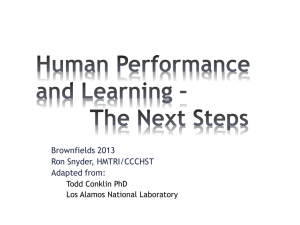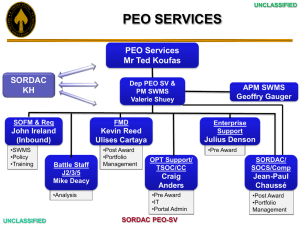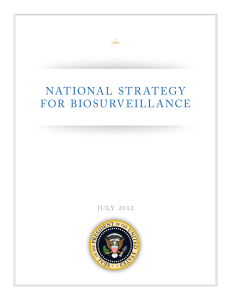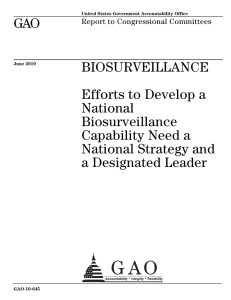Building Bio-Surveillance Systems for Early Detection of
advertisement
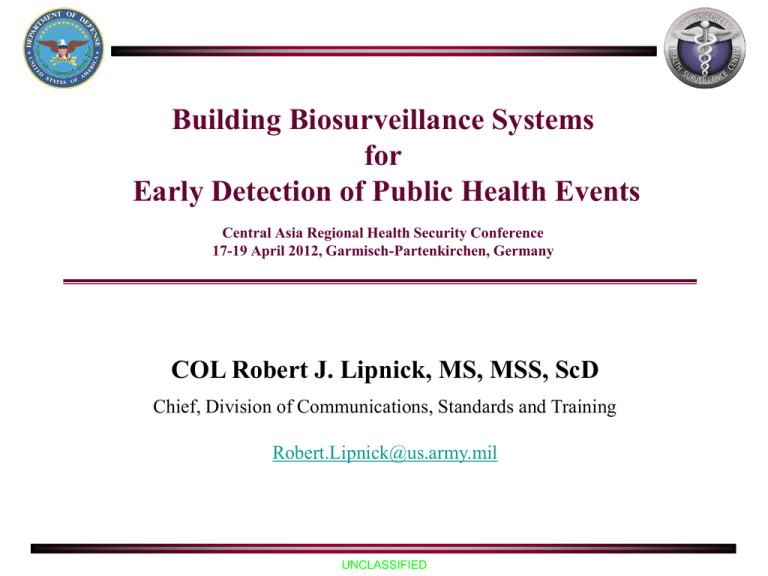
Building Biosurveillance Systems for Early Detection of Public Health Events Central Asia Regional Health Security Conference 17-19 April 2012, Garmisch-Partenkirchen, Germany COL Robert J. Lipnick, MS, MSS, ScD Chief, Division of Communications, Standards and Training Robert.Lipnick@us.army.mil UNCLASSIFIED Outline • Define “biosurveillance” • Describe the major elements of an effective biosurveillance • • system Explain how biosurveillance systems improve compliance with International Health Regulations (2005) List major challenges to implementing an effective biosurveillance system UNCLASSIFIED The Cost of Epidemics • Many diseases preventable or controllable by modifying: – – – – – Behaviors and activities Vaccination Public water/sewer systems Food quality and quantity Disease detection and early treatment • Early detection and control reduces burden of disease – – – – – Deaths Disability Lost productivity and income Political and social instability Increased demand on healthcare services UNCLASSIFIED Early Detection Benefit WHO World Health Report 2007 UNCLASSIFIED Biological Surveillance • “Biosurveillance” – Ongoing, consistent collection of data relevant to human and animal health – Using well-designed systems that increase the speed of data collection, analysis and reporting – To detect abnormal events or trends (epidemics) – Quickly enough to prevent significant impact on health or social stability UNCLASSIFIED Disease or Syndrome • Disease report specifies a pathogen: Influenza – Clinical diagnosis (astute medical provider) – Laboratory test result – Can result in biological sample • Confirmation of diagnosis • Molecular data • Repository for future studies – Delayed acquisition of data but high degree of certainty – Used for threats with high epidemic potential – Key challenge: laboratory capabilities UNCLASSIFIED Disease or Syndrome • Syndrome report covers a less specific category of disease: Influenza-like illness – – – – – Signs and symptoms of disease Non-specific laboratory data Defined by expert consensus Data quickly available but lower degree of certainty Routine health surveillance or detection of emerging “unknown” threat – Key challenge: data system UNCLASSIFIED Major Elements of Biosurveillance System • Data collection – Many different sources – Determined by local epidemiology – Limited by technology, training and human resources • Analysis – Looking for “more than expected” numbers of cases or change in disease pattern – Mathematical, automated systems available – Combination of information from many sources usually needed for full response • Reporting • Outbreak response UNCLASSIFIED Collection of Surveillance Data • Medical care – Notifiable disease reports – Periodic case counts – Medical record abstraction • Use of commercial products and services • Population-based survey • Social media • Targeted surveillance programs • Syndromic surveillance UNCLASSIFIED “Syndromic” Data • Automated collection and analysis of electronic records • Uses diagnostic coding or other information to automatically assign syndrome category – – – – International Classification of Diseases Procedure codes Laboratory codes Interpretation of text • Typically very fast analysis but non-specific disease categories • Relies on mathematical formulas • Typically generates many “false alerts” • Still need traditional sources of health surveillance UNCLASSIFIED Systematic Representativeness • Multiple surveillance Population Survey types needed to cover all potential threats • Understand source of data for proper interpretation • Different surveillance for different problems • Make decisions with less than complete information Social Media Products and Services Medical Care Targeted Programs UNCLASSIFIED Timeliness Versus Certainty • Timeliness critical for rapid detection and response • Certainty needed to ensure proper response • Drawbacks from favoring timeliness – Less specific – Less representative – Potentially many false positive alerts • Drawbacks from favoring certainty – Delayed by confirmation methods – Requires complex laboratory systems – Requires many highly trained workers • Combine data sources and surveillance methods to balance timeliness and certainty UNCLASSIFIED Detecting Abnormal Events • Requires knowledge about normal disease patterns – “baseline” • Special epidemiologic, environmental or ecologic studies may be necessary • Enough information to make a quick decision • Define a threshold for investigation • False positive signals can cause “surveillance fatigue” • Design or modify system to reduce false negatives UNCLASSIFIED What is Abnormal? • Higher than expected numbers of cases – – – – Overall increases Increases in specific populations Increase in severe cases Cases that should be very rare • Events with epidemic potential – – – – Focus of International Health Regulations (2005) Represent potential to cause large numbers of cases (deaths) Can result in social instability and economic strain Cross regional boundaries • Biosurveillance system detects cases/events prior to impact on population UNCLASSIFIED Electronic Data Systems • Move information from the “ground level” to the epidemiologist – – – – Medical visit documentation Financial transactions and supply distributions Personal observations Standardized field reports • Faster is better – – – – Automated data transfer Text messaging and Smartphone applications Web-based data entry Email, fax or phone UNCLASSIFIED Analysis and Reporting • Determine when a public health response is needed • Team of epidemiologists, medical personnel, computer specialists and public policy staff needed – Routine and systematic databases – Cyclical analysis and graphical reports – Standard operating procedures • Communicate results to stakeholders and decision-makers – – – – Address major concerns Provide interpretation along with information Provide appropriate level of detail Create forum for discussion UNCLASSIFIED International Health Regulations (2005) • Public health threats cross political boundaries • IHR 2005 requires identification and reporting of public health emergencies of international concern (PHEIC) • Biosurveillance systems designed to: – Identify reportable cases or events – Improve health of the population through control of nonreportable epidemics • Regional analysis of surveillance information allows coordination of response UNCLASSIFIED Planning and Exercising • Evaluate (measure) – – – – Timeliness Certainty Representativeness Effectiveness of response • Exercises and “experiments” critical – – – – – Discover gaps in diseases, syndromes, populations Identify training and human resource gaps Practice coordination of response actions Plan for purchase of equipment and supplies Develop new methods and technologies UNCLASSIFIED Substantial Challenges • Information and communications technology • Training and human resources • Coordination among many different parts of government and civil society • Rapid and effective communication • Decision-making with imperfect information • Protection of personal privacy • Communication of information to the public UNCLASSIFIED Conclusions • Using various data collection and surveillance methods balance timeliness, certainty and representativeness • Regional and global coordination improves ability to respond quickly and effectively • No system is perfect, but many can be good enough • Every system must be evaluated, exercised and modified over time to meet new challenges • IHR 2005 provides the basic requirements for all nations UNCLASSIFIED Questions? COL Robert J. Lipnick, MS, MSS, ScD Chief, Division of Communications, Standards & Training Robert.Lipnick@us.army.mil UNCLASSIFIED
